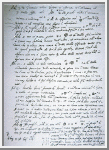|
PHOTO INDEX OF
PRIMARY TARGETS
|
|---|
ASTEROIDS
COMETS
EARTH
JUPITER
KUIPER BELT
MARS
MERCURY
METEORITES
NEPTUNE
OORT CLOUD
PLUTO
SATURN
SOLAR SYSTEM
SPACE
SUN
URANUS
VENUS
ORDER PRINTS
ALL TARGETS
PHOTO CATEGORIES
SCIENCEVIEWS
AMERICAN INDIAN
AMPHIBIANS
BIRDS
BUGS
FINE ART
FOSSILS
THE ISLANDS
HISTORICAL PHOTOS
MAMMALS
OTHER
PARKS
PLANTS
RELIGIOUS
REPTILES
SCIENCEVIEWS PRINTS
|
 |
 |
Galileo's Discovery of the Galilean Satellites
| Target Name: | Jupiter |
| Copyright: | NASA Copyright Free Policy |
|
Related Document
Download Options
This is a page from Galileo's published discovery of the
Galilean Satellites which appeared in Sidereus Nuncius
in March 1610.
"I should disclose and publish to the world the occasion of discovering and
observing four Planets, never seen from the beginning of the world up to
our own times, their positions, and the observations made during the last
two months about their movements and their changes of magnitude; and I
summon all astronomers to apply themselves to examine and determine their
periodic times, which it has not been permitted me to achieve up to this
day . . . On the 7th day of January in the present year, 1610, in the first
hour of the following night, when I was viewing the constellations of the
heavons through a telescope, the planet Jupiter presented itself to my view,
and as I had prepared for myself a very excellent instrument, I noticed
a circumstance which I had never been able to notice before, namely that
three little stars, small but very bright, were near the planet; and although
I believed them to belong to a number of the fixed stars, yet they made me
somewhat wonder, because they seemed to be arranged exactly in a straight
line, parallel to the ecliptic, and to be brighter than the rest of the
stars, equal to them in magnitude . . .When on January 8th, led by some
fatality, I turned again to look at the same part of the heavens, I found
a very different state of things, for there were three little stars all
west of Jupiter, and nearer together than on the previous night."
"I therefore concluded, and decided unhesitatingly, that there are
three stars in the heavens moving about Jupiter, as Venus and
Mercury around the Sun; which was at length established as clear as
daylight by numerous other subsequent observations. These observations
also established that there are not only three, but four, erratic
sidereal bodies performing their revolutions around Jupiter."
|
|
